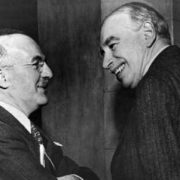The Fight Continues: Keynes and Hayek on Prices
F.A. Hayek and John Maynard Keynes are two of the most controversial economists in history. They are also the two that are most often mentioned in undergrad economics courses. But even though these two have managed to break through to the mainstream, many still do not fully understand the differences between the two economists’ beliefs.
Previously, I discussed how Hayek and Keynes differed in regards to their views on spending and planned economies. Hayek, whose views were closely aligned with the Chicago school of economics, believed that markets operate organically and, as such, should not be constrained to the confines of government orchestration. This led him to conclude that government intervention, including but not limited to the setting of prices, inhibits the free market from reaching its full potential.
Keynes, on the other hand, believed the exact opposite. For Keynes, the more government intervention the better. He believed that laissez-faire economics was dangerous for consumers and was destined to fail. This faith in government institutions would also transfer over to his views on price theory.
Keynes on Pricing
Like most things regarding the economy, Keynes was a huge advocate of government intervention. As George Selgin put it, Keynes’s believed that “government authorities should manage money so as to achieve a stable level of consumers’ prices.”
Expanding on this, Selgin says:
“But, although some of Keynes’s writings, and the General Theory especially, may have laid the groundwork for inflationary policies, Keynes himself regarded them as supporting a monetary policy that would stabilize consumers’ prices. The desirability of a stable consumers’ price index is a persistent theme of Keynes’s monetary writings, from the Economic Consequences of the Peace (1919) to How to Pay for the War (1940). In this respect at least Keynes saw eye-to-eye with several of his more important contemporaries, including Irving Fisher and such members of the “old” Chicago School as Loyd Mints and Henry Simons.”
Keynes believed that prices were closely tied to monetary policy. Selin says, “But, although some of Keynes’s writings, and the General Theory especially, may have laid the groundwork for inflationary policies, Keynes himself regarded them as supporting a monetary policy that would stabilize consumers’ prices.
Let the Market Do Its Thing
For anyone familiar with Hayek, it will not be surprising to learn that he believed that prices are an organic product of the market. Since Hayek believed that the market was capable of operating without constant government supervision, he thought it was unwise to give the government the power to determine prices.
Instead, he believed that prices were a response to market demand. If an item was proving itself to be of value to willing consumers, that demand would provide a basis for entrepreneurs to structure pricing.
To explain this in more technical economic terms, Selgin explains that Hayek, “believed that the general level of output prices should be allowed to vary in response to changes in factor productivity, falling in response to both anticipated and unanticipated improvements in productivity, and rising in response to any productivity setback.”
Until demand dies down, and consumers are demonstrating their unwillingness to pay a certain price for an item or service, there was no reason to reduce prices. If, on the other hand, demand continues to climb, entrepreneurs and business owners may decide to raise the price of a good or service since it is proportional to the demand. Keynes would have never trusted the market enough to believe that prices could be set and stabilized through demand.







